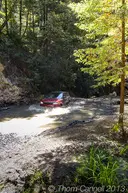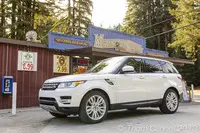2014 Range Rover Sport On and Off Road Review
Completeness of Purpose; with its stunning power and selective breeding the 2014 Range Rover Sport has the
ability to safely take you anywhere, with grace and bespoke elegance fit
for a discerning taste.
By Thom Cannell
Senior Editor
Michigan Bureau
The Auto Channel
Just this once we wish we could avoid analysis of style, elegance
and design, ignore headlamps and tail lamps, massive sun roofs, a selection
of huge tires and sparkling wheels. Instead we would speak only
about the kind of raw power few sports cars can envision, or maybe
we’d invest in a tale of an off road prowess so mighty and bold that
even Jeeps quail in comparison.
We might discuss an ability to ford water
deeper than you’d care to wade. But, what if all of this
capacity and proficiency were packed beneath the skin of a single vehicle,
one with stunning power, grace and bespoke elegance fit for discerning
tastes, yet welded to an ability to go literally anywhere.
Such is
the story of the new Range Rover Sport.
Though envisioned as a sporting version of the Range Rover, itself a
vehicle that embodies similar attributes, it is its own master. Factually,
75% of the Sport differs from the parent, though engineering systems were
shared in development.
An all-aluminum vehicle, it is more aircraft than
car as its panels are riveted and bonded instead of welded.
The result is
as stable a container for passengers as you could imagine, and as close to
a billet as a suspension engineer could wish for. The new Sport has shed
800 pounds compared to the outgoing sibling, and though it is hard to
suggest that a vehicle weighing over 5,000 pounds is svelte, it dances that
way. Of course options and choices can negate the reduction; it nonetheless
feels as poised as most sport sedans.
Let us deliver the pertinent powertrain facts. For the North
American market Land Rover uses a 340 horsepower Supercharged 3.0-liter V-6
or 510 horsepower Supercharged V-8.
While the V-6 is swifter than the
outgoing V-8, its torque as on tap as surely as any blown dragster, it is
the 5.0-liter V-8 that will take your breath away as it rockets to 60 miles
per hour in just five seconds.
We are assured that without its power
control systems it would literally do so, lapping any track drifting as
sideways as you might venture to control for as long as your testosterone
drip lasted. Both motors are mated to a seamless 8-speed transmission
furnished by ZF, and two different approaches to dirt are available. One, a
Torsen single-speed transfer case is for those who will never venture to
Moab, Baja, Atacama or genuinely adventuring off the road. The other is a
two-speed electronically activated transfer case with low range. This is
the system of legend and capacity, and totally electronic.
Should you venture off the road in one of these luxurious beasts
there are some suggestions worth sharing. First, if you’ve not
pointed a vehicle off the top or a hill, or at one, get instruction from a
school or club. There are techniques as subtle as fly fishing or
three-corner billiards, though with those endeavors life threatening injury
is unlikely.
The second bit is to let the Range Rover Sport make
your decisions. Though you can select settings designed for
Grass/Gravel/Snow, Mud/Ruts, Sand, and Rock Crawl using the rotary Terrain
Response 2 control, each with suitable modifications to engine speed,
downhill braking control, steering response, ride height, chassis systems
and more, only an expert need do so. Or if you were actually only on in the
erg or driving on Sweden’s snow and ice lakes where lazy torque
application would be positively beneficent.

|
Enabling this is an independent aluminum suspension, doubly isolated
in front and with multilink rear. Wheel travel is around 260-272 mm or 10+
inches which results in 546 mm of articulation, considerably more than even
a Jeep Wrangler. Ride height is variable (you do know the Range Rover Sport
is tall? 70.1 inches tall?) and off the road height jumps 1.4 inches, up to
2.6” taller ruled by four-corner air suspension. It also lowers to
facilitate easier ingress/egress. Maximum selectable height extension 185
mm, roughly seven inches. Factor this into your decisions to jump out for a
quick photograph as you will surely desire a step ladder for reentry.
If you have never experience automated off-roading, it is
disconcerting to point your nose off a steep decline and follow the rule,
“feet off the gas and brake, just steer.” And maybe shift from
Low 1st gear to Low 2nd as the Sport descends with dignity. Oh, if
you’ve tried other, older Hill Descent, this one is quiet, no
clanking and shop-floor graunching of solenoids and brakes. Slick and
sophisticated, this one.

|
We must discuss other attributes, like driving on pavement.
Regardless engine the Sport is more sports sedan than ponderous SUV. Rather
than feeling atop a bronco there is the connectedness of a motorcycle and
enclosure of a sedan. You sit in instead of atop. In traffic the V6 scoots
around as if smaller and lighter while the V8 emits a sold and soul
stirring rumble. Part of the engine sounds is imported into the normally
silent cabin, a device allows the engine to join you when called upon. This
artifice is in addition to a genuine rumble heard from outside or from and
open window.
Befitting a luxury car the Sport is normally very, very
quiet. Engineers proudly display charts proving it is quieter than main
competitors BMW X5, Audi Q7, Porsche Cayenne. So the imported noise is a
welcome guest, not a party crasher.
All models now feature a very well developed electric power
steering system. The world calls it EPAS and many curse its invention (and
emissions related adoption) as rubbery or vague. Not so here.
Iteration after iteration has created a solid, connected feel that is
slightly less powerful just off center to enhance control at speed. Its
calibration—the feel and response—vary according to condition
selected. Perhaps you’ve dialed the proper suspension calibration for
a snowy day or driving on gravel roads, but steering feel remains solidly
connected with total absence of that rubbery feeling. You will like it.
Sport models are equipped with dynamically active rear locking
differentials for traction, on/off road handling, and stability. The new
system is far faster, 70 ms faster, than the outgoing. It also employs
torque vectoring using the brakes to direct power to the wheel that has
traction, or the wheel that can best help you point into a corner errant
enthusiasm has miscalculated.
Range Rover Sport’s catalog of electronic aids includes no
less than fourteen powerful acronyms lined up to assist you in stabilizing
(DSC and RSC), sticking (ETC), towing (TSA), descending (HDC, GRC, EDC),
ascending (HSA), braking (ABS, EBD, EBL, EBA, CBC) and EPB or an electronic
parking brake. Oh, and that is only the very beginning of amazing things
the vehicle, properly equipped, can do. It can help you park, assist you in
exiting tight parallel parking, even use its multiple sensors to identify
parking spaces suitably wide to back into—and collaborate in that
endeavor.
We will leave appraisal of its readily identifiable and familial
exterior to you, though we should note its 191” length is barely
longer than its predecessor and shorter than many mid-sized sedans, and
that it is nearly 6” shorter than Range Rover. Surely you will notice
the side fender vents for stream fording, clamshell hood and two-bar
grille, and a roof line that appears to hover above the body.
Evaluation of the interior is also yours, noting that glove leather
seats are a discrete swivel away from your hips in a cabin decorated in a
choice of three woods or four aluminum finishes. British audiophile
manufacturer Meridian provides sound, and the driver is optionally assisted
by advanced technologies like lane departure warning, recognition of
traffic signs, automatic high beam assist, sensors that assist in
preventing tight space side impacts, adaptive cruise control, and many,
many more.
We could go on about the seamless Stop/Start system, regenerative
battery charging, reverse radar detection or other instances of useful
assistance but the intent is clear, to abet driver safety.
What we
cannot share is the sense of completeness of purpose the 2014 Range Rover
Sport delivers, its sports sedan road manners and simultaneous competence
off road. Those you will have to experience for yourself. And we should
mention pricing starts at $63,495, competitive in the segment while
delivering far more off road capacity than rivals. Yes, you can spend
$93,295 for the ultimate Autobiography edition and even option that with
5+2 seating in a third row that replaces the spare tire.
More
commonly the 2014 Range Rover Sport Supercharged V-8 will, at $79,995, be a
high volume model, one that satisfies a majority of power users who wish to
choose options they prefer. The only question is will your test drive be on
pavement, snow, ice, slick rock, mud or dirt?


















